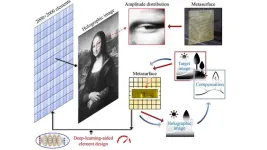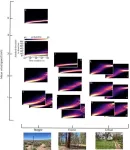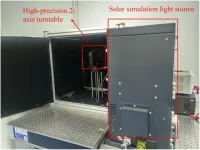(Press-News.org) Proteins are biological molecules that perform almost all biochemical tasks in all forms of life. In doing so, the tiny structures perform ultra-fast movements. In order to investigate these dynamic processes more precisely than before, researchers have developed a new algorithm that can be used to evaluate measurements at X-ray free-electron lasers such as the SwissFEL more efficiently. They have now presented it in the journal Structural Dynamics.
Sometimes, when using the navigation system while travelling by car, the device will locate you off the road for a short time. This is due to the inaccuracy of the GPS positioning, which can be as much as several metres. However, the algorithm in the sat nav will soon notice this and correct the trajectory displayed on the screen, i.e. put it back on the road.
A comparable principle for addressing unrealistic motion sequences has now been successfully applied by a team of researchers led by PSI physicist Cecilia Casadei. However, their objects of investigation are about a billion times smaller than a car: proteins. These building blocks of life fulfil crucial functions in all known organisms. In doing so, they often perform ultra-fast movements. Analysing these movements precisely is crucial for our understanding of proteins which can help us produce new medical agents, amongst other things.
How to "film" proteins...
To further improve the understanding of protein movements, Casadei, together with other PSI researchers, a researcher at DESY in Hamburg and other colleagues at the University of Wisconsin in Milwaukee, USA, has developed an algorithm that evaluates data obtained in experiments at an X-ray free-electron laser (XFEL). An XFEL is a large-scale research facility that delivers extremely intense and short flashes of laser-quality X-ray light. Here, a method called time-resolved serial femtosecond X-ray crystallography (TR-SFX) can be used to study the ultra-fast movements of proteins.
The measurements are very complex for several reasons: the proteins are much too small to be imaged directly, their movements are incredibly fast, and the intense pulse of X-ray light of an FEL completely destroys the proteins. On the experimental level, TR-SFX already solves all these problems: no individual molecule is measured, but rather a large number of identical protein molecules are induced to grow together in a regular arrangement to form protein crystals. When the FEL X-ray light shines on these crystals, the information is captured in time before the crystals and their proteins are destroyed by the pulse of light. The raw data from the measurements are available as so-called diffraction images: light spots that are created by the regular arrangement of the proteins in the crystal and registered by a detector.
... and how to evaluate the measurement data
Where the experimental challenges have been overcome, the evaluation of the data is just beginning. "The measurement of each individual crystal provides only two percent of the data of a complete image." This incompleteness has physical and experimental reasons and can only be eliminated by combining the measurement data of many crystals in a meaningful way. Casadei's research focuses on exactly how to go about this.
The method established so far is called "binning and merging". "A lot has been achieved with this method in the last decade," says Casadei. With this method, the data are divided into time intervals and all data within one interval, a "bin", are averaged. However, a lot of detailed information is also lost in this averaging. "You could say that the individual images of the protein film are then all a bit washed out," Casadei continues. "That's why we have developed a method that allows us to get more out of the measurement data."
The new method devised by Casadei and her colleagues is called "low-pass spectral analysis", or LPSA for short. "Similar to electronics or audio technology, we apply a low-pass filter," Casadei explains. "However, in our case it comes in the form of advanced linear algebra. We apply these formulas to remove unwanted noise from the data without losing the relevant details."
In short and simple terms, the raw data, i.e. the diffraction images of the protein crystals, are tracked throughout the protein motion. This movement is assumed to be smooth, i.e. jerk-free. Similar to how the navigation system corrects itself when the car seemingly leaves the course of the road, the new algorithm by Casadei and her colleagues mitigates errors of the protein movement reconstruction.
HDR for protein films
Lay people may not notice an immense difference in the new protein films. But for the cineastes at X-ray free-electron lasers, the improvement is comparable to switching from a DVD film to HDR quality.
"Above all, the new algorithm now allows researchers here at SwissFEL at PSI to extract more information from their data," says Casadei. Conversely, this means the algorithm can help shorten long measurement times. Since beam time is always in high demand at large-scale research facilities, and in particular at SwissFEL, this is a most welcome prospect for protein researchers using this highly advanced facility.
Text: Paul Scherrer Institute/Laura Hennemann
About PSI
The Paul Scherrer Institute PSI develops, builds and operates large, complex research facilities and makes them available to the national and international research community. The institute's own key research priorities are in the fields of matter and materials, energy and environment and human health. PSI is committed to the training of future generations. Therefore about one quarter of our staff are post-docs, post-graduates or apprentices. Altogether PSI employs 2100 people, thus being the largest research institute in Switzerland. The annual budget amounts to approximately CHF 400 million. PSI is part of the ETH Domain, with the other members being the two Swiss Federal Institutes of Technology, ETH Zurich and EPFL Lausanne, as well as Eawag (Swiss Federal Institute of Aquatic Science and Technology), Empa (Swiss Federal Laboratories for Materials Science and Technology) and WSL (Swiss Federal Institute for Forest, Snow and Landscape Research). Insight into the exciting research of the PSI with changing focal points is provided 3 times a year in the publication 5232 - The Magazine of the Paul Scherrer Institute.
Contact
Dr. Cecilia Casadei
Laboratory of Biomolecular Research
Paul Scherrer Institute, Forschungsstrasse 111, 5232 Villigen PSI, Switzerland
Telephone: +41 56 310 55 17, e-mail: cecilia.casadei@psi.ch [English, Italian, French]
Original publication
Low-pass spectral analysis of time-resolved serial femtosecond crystallography data
C. M. Casadei, A. Hosseinizadeh, T. Weinert, J. Standfuss, R. Fung, G. F. X. Schertler, R. Santra
Structural Dynamics, 26.05.2023 (online)
DOI: 10.1063/4.0000178
END
An algorithm for sharper protein films
2023-05-30
ELSE PRESS RELEASES FROM THIS DATE:
4,000-year-old plague DNA found – the oldest cases to date in Britain
2023-05-30
Researchers at the Francis Crick Institute have identified three 4,000-year-old British cases of Yersinia pestis, the bacteria causing the plague – the oldest evidence of the plague in Britain to date, reported in a paper published today in Nature Communications.
Working with the University of Oxford, the Levens Local History Group and the Wells and Mendip Museum, the team identified two cases of Yersinia pestis in human remains found in a mass burial in Charterhouse Warren in Somerset and one in a ring cairn monument in Levens in Cumbria.
They took small skeletal samples from 34 individuals across the ...
The making of a Mona Lisa hologram
2023-05-30
WASHINGTON, May 30, 2023 – Holograms are often displayed in science fiction as colorful, life-sized projections. But what seems like the technology of the future is actually the technology of the present, and now it has been used to recreate the Mona Lisa.
In Applied Physics Reviews, by AIP Publishing, researchers from Tianjin University, the Beijing Institute of Technology, Rowan University, the University of Missouri, Qingdao University, Shijiazhuang Tiedao University, and Beijing Jiaotong University developed an acoustic metasurface-based holography technique that uses a deep learning algorithm to generate and iteratively ...
How insects track odors by navigating microscale winds
2023-05-30
WASHINGTON, May 30, 2023 -- How do flying insects like important pollinators locate odor sources in the great outdoors, despite encountering highly variable wind conditions? They use odor plumes — which travel like smoke and form when the wind blows odor molecules from their source — to track down sources such as flowers or pheromones.
But wind tunnels are typically unable to replicate realistic outdoor wind conditions. In Physics of Fluids, by AIP Publishing, University of Nevada at Reno researchers decided to explore microscale wind conditions in various outdoor environments to better understand what flying insects might experience while tracking odor plumes.
Authors ...
Sleep health before SARS-CoV-2 infection and risk of long COVID
2023-05-30
About The Study: The findings of this study that included 1,979 women indicate that healthy sleep measured prior to SARS-CoV-2 infection, both before and during the COVID-19 pandemic, may be protective against post–COVID-19 condition (PCC), also known as long COVID. Future research should investigate whether interventions on sleep health may prevent PCC or improve PCC symptoms.
Authors: Siwen Wang, M.D., of the Harvard T. H. Chan School of Public Health in Boston, is the corresponding author.
To access the embargoed study: ...
Association between heart attack and cognition
2023-05-30
About The Study: In this study of 30,465 adults without myocardial infarction (MI; heart attack), stroke, or dementia, overall, incident MI was not associated with an acute decrease in global cognition, memory, or executive function at the time of the event compared with no MI. The rate of decline in global cognition, memory, and executive function was significantly faster over the years for adults with an MI event compared with those without an MI. These findings suggest that prevention of MI ...
Volunteering, health, and well-being of children and adolescents
2023-05-30
About The Study: Using survey data from across the United States, researchers found that volunteering was associated with higher odds of excellent or very good health and flourishing in children and adolescents, and with lower odds of anxiety in adolescents and behavioral problems in children and adolescents.
Authors: Kevin Lanza, Ph.D., of the Michael & Susan Dell Center for Healthy Living in Austin, Texas, is the corresponding author.
To access the embargoed study: Visit our For The Media website at this link https://media.jamanetwork.com/
(doi:10.1001/jamanetworkopen.2023.15980)
Editor’s ...
Use of metabolic and bariatric surgery among youth
2023-05-30
About The Study: Use of and access to metabolic and bariatric surgery (MBS) have increased among U.S. youth and among most racial and ethnic groups. Compared with 2015-2019, MBS use in youths increased significantly in 2020-2021 during the first 2 years of the COVID-19 pandemic. In contrast, MBS rates in adults decreased in 2020.
Authors: Sarah E. Messiah, Ph.D., of the University of Texas Health Science Center at Houston School of Public Health—Dallas Campus, is the corresponding author.
To access the embargoed study: Visit our For The Media website at this link https://media.jamanetwork.com/
(doi:10.1001/jamapediatrics.2023.0803)
Editor’s ...
Racial, ethnic, and language disparities in identifying and mitigating central line–associated bloodstream infections
2023-05-30
About The Study: The results of this study of 8,269 pediatric patients show disparities in central line–associated bloodstream infection rates for Black patients and patients who speak a language other than English that persisted after adjusting for known risk factors, suggesting that systemic racism and bias may play a role in inequitable hospital care for hospital-acquired infections. Stratifying outcomes to assess for disparities prior to quality improvement efforts may inform targeted interventions to improve ...
Philosophy aligns with economics on how to value future generations in climate policy
2023-05-30
A survey of philosophers finds they broadly agree with economists on the best way of valuing the environment of the future in policy decisions made now – although for different reasons.
In a new study published in Nature Climate Change, environmental economists including the University of Exeter’s Professor Ben Groom found consensus between the two academic disciplines over an aspect of climate policy known as the ‘social discount rate’, with philosophers offering support for a rate of 2% - a value predominantly backed by economists, and which is in line with UN climate ...
Researchers proposed a deep neural network-based 4-quadrant analog sun sensor calibration
2023-05-30
A spacecraft can estimate the attitude state by comparing external measurements from attitude sensors with reference information. CubeSats tend to use 4-quadrant analog solar sensors which have the advantages of extremely low power consumption, minimal volume, low complexity, low cost, and high reliability as attitude sensors, considering the limitation of satellite volume and payload. The performance of the sensor can be importantly improved by the calibration procedure and compensation model. However, the various error sources affecting the calibration of the 4-quadrant sun sensor lead to a complicated ...






